
views
Getting Ready to Plant
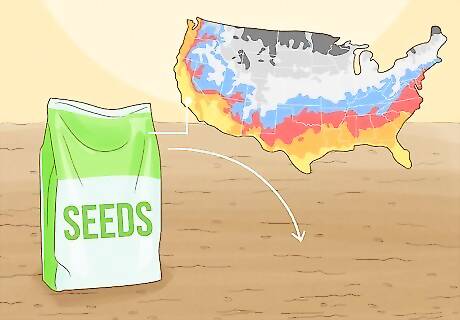
Select a type of plant that thrives in your growing region. Not all plants can grow in every region. An area's temperature and climate factor greatly in the plant's chances of success. If you live in a northern region, for example, you'll have trouble growing a plant native to a tropical rainforest. When you pick out seeds to plant, do a little research to make sure the plant species does well in your area. If you have a greenhouse or plan to grow your plant indoors, you may be able to plant a seed even if the species is not native to your growing region. A good way to figure out what plants grow well in your area is to visit a local nursery and talk with an employee there. He or she will be able to help you pick out hardy seeds that have a great chance of germinating and growing into healthy plants. Some seeds are easy to plant in many growing regions and under a lot of different conditions. Look for "easy seeds," which are hardy and simple to grow for the beginning gardener. In the US, you can look up your USDA hardiness zone. Find a seed that grows well in your zone.

Know what time of year to plant the seed. The time of year you plant seeds is determined by both the plant's needs and your growing region. If you live in a place with long, cold winters, you may need to wait until mid-Spring to plant your seeds. If you live in a place that warms up early in the year, you can probably start earlier. Check your seed packet for information on how early to start your seeds. Starting seeds too early or late can prevent germination from occurring, so it's important to figure out the right time to plant to ensure success. If you are starting seeds indoors, you should keep in mind that most vegetable seeds need to be started at least two weeks before the last frost, and some as early as 2-3 months before the last frost. Even if you live in a cold area, you'll need to plan ahead to make sure you start your seeds in time for the growing season. Some seeds should be planted directly in the soil outside. Always research your specific seed and plant to understand how best to start it.
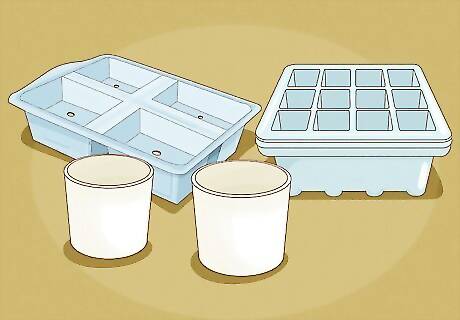
Get seed-starting supplies. Most seeds need similar growing conditions when they're first starting out. When the seeds sprout and grow into plants, they'll have more specific needs in terms of soil, sun, and temperature conditions. To get ready for planting seeds, you'll need the following supplies: Seed containers. Each seed will need 1–2 inches (2.5–5.1 cm) of space to germinate and take root. You can grow them all together in an open flat, or choose individual seed containers. Try making your own containers out of recycled yogurt cups or egg cartons. Seed growing medium. Seeds contain all the nutrients they need to germinate, so there's no need to use a growing medium that has been enriched with nutrients. Don't use potting soil, since it's too dense for fragile new roots to penetrate. Use a mix of vermiculite or perlite and either peat moss, coir, or compost. Nurseries sell bags of seed-starting mix if you don't want to make your own. Depending on what you are growing, you may need equipment to provide enough light and heat. Some seeds do much better with a heat mat under the soil, and many require overhead lighting. When considering grow lights, research what how much light a plant requires and how intense the lighting should be.
Starting Seeds Indoors
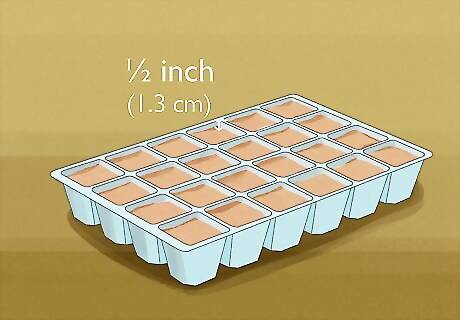
Prepare the growing containers. Start by moistening the seed-starting medium thoroughly, so that it provides a good growing environment for the seeds. Fill the containers with the medium, leaving about ⁄2 inch (1.3 cm) of space between the top of the growing medium and the rim of the containers. Place the containers in a sunny, well-ventilated area with a steady, warm temperature.
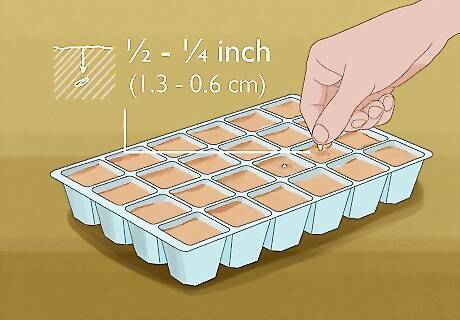
Sow the seeds. The way you sow your seeds is depending on what type of plant you're growing, so it's necessary to read the seed packet carefully first. Many seeds can be scattered evenly across the surface of the growing medium. Be sure not to place too many seeds in the same growing container, since you don't want them to crowd each other too much. Most seeds should be planted twice as deep as they are wide. Some seeds should be planted about ⁄2 to ⁄4 inch (1.3 to 0.6 cm) below the surface of the growing medium. Check your seed pack to make sure you sow the seeds correctly. Some seeds do best when they are chilled or soaked before sowing. Be sure you're providing the right sunlight conditions for your specific seed species. Most seeds can germinate without light, but they'll need sun as soon as they sprout. Most seeds do best with a temperature of about 78 degrees, but some need colder or warmer conditions to germinate.
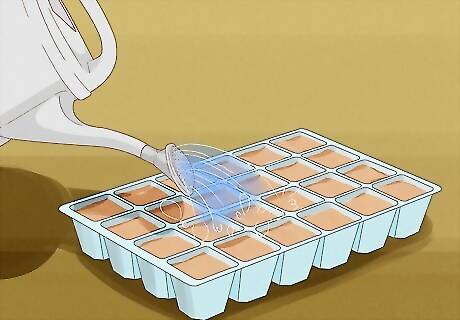
Keep the seeds moist. Seed growing medium tends to dry out quickly, since there's no soil to hold the water. Be sure to water the seeds consistently, never allowing them to dry out too much. You can lightly drape a piece of plastic wrap over the seed trays to help trap in moisture. Don't overwater the containers, or the seeds could become waterlogged. They should be moist, but not dripping wet.
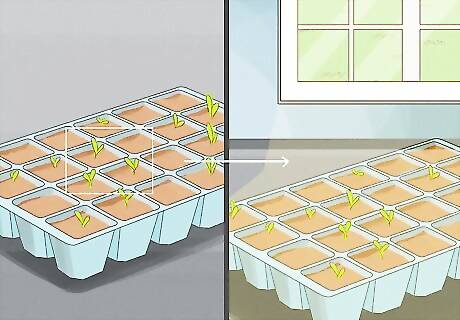
Keep the seedlings healthy. As the seeds sprout into seedlings, you'll see thin green stems emerge from the growing medium. If the containers aren't already placed in a sunny area, be sure to move them to a place with direct sunlight or provide them with grow lights overhead. Keep them moist at all times and make sure the temperature never drops below the recommended level. You can place a heat mat under the seed starting tray to maintain the correct temperature.
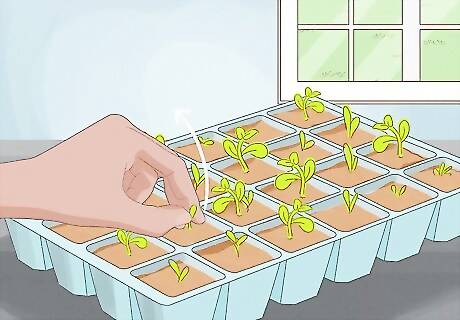
Weed out the weaker seedlings. After a week or two, weed out the weaker-looking seedlings so that the stronger ones have more room to grow. Leave about 2 - 3 seedlings per container.
Transplanting Seedlings
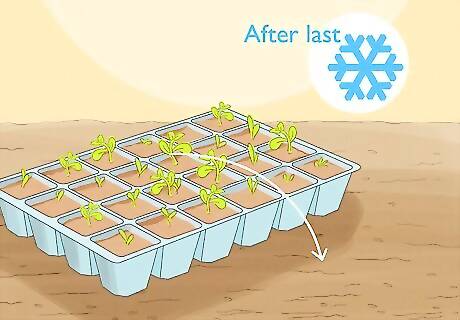
Plan to transplant after the last frost. If you timed the planting right, the seedlings should have a set of mature leaves and be ready to transplant in time for the growing season, which starts after the last frost of the year. This falls in a different month depending on where you live. If you're unsure when the last frost might take place, ask for advice at your local nursery.
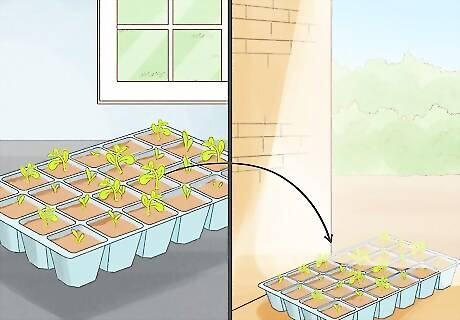
Move the seedling container to a covered outdoor area. A few days before you're ready to plant the seedlings, move them to an outdoor shed or garage. Start by giving them an hour outside a day, and increase the amount of time over a week or two. This helps them get used to the outdoor climate before you place them directly in the ground. Without this extra time to acclimate, the shock of the transplant may cause them to suffer. If you don't have a covered outdoor area, you can place the seedlings outside and construct a makeshift shelter. Leave them in the sun during the day, and cover them with a cardboard box to protect them from the wind at night. You could also match the temperature in the room where the seedlings are kept to the temperature outside.
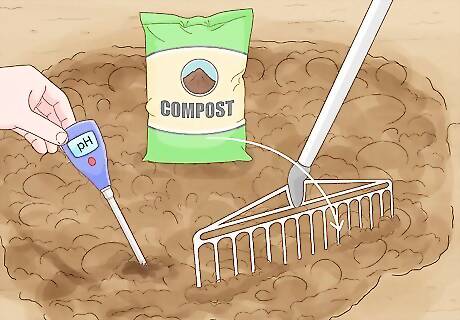
Prepare the planting bed according to the plant's needs. The planting bed should be located in an area that gets the proper amount of sunlight and shade your plant needs. The soil should have the correct pH balance and composition of nutrients. Be sure that it drains well, too. You can change the pH of the soil by adding amendments like compost or manure. If you are doing this, you should prepare the bed a week or two before planting.
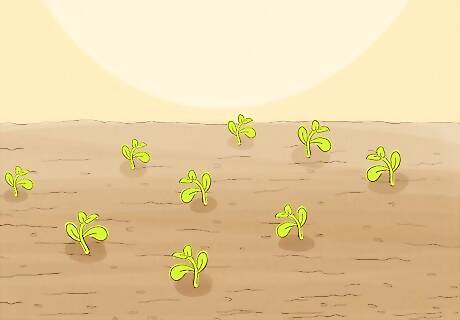
Plant the seedlings in the ground. Dig holes in the ground that are roughly the size of your seedling containers. Make sure the holes are spaced far enough apart so that the plants have plenty of room to grow. Carefully lift the seedlings from their containers, gently separate the root balls a bit, and plant them in the holes.
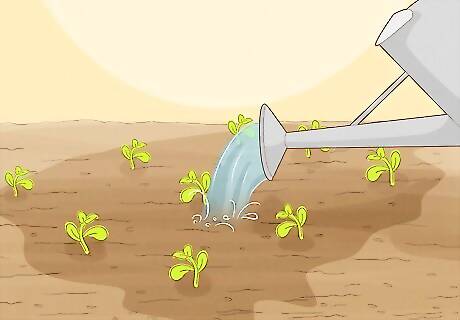
Water and fertilize the seedlings. As they grow, continue providing the correct conditions for the plants to grow healthy.














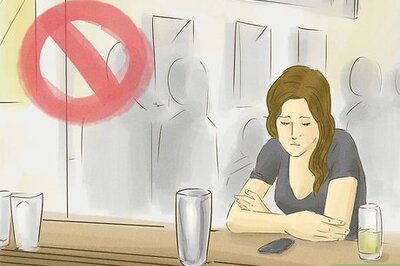
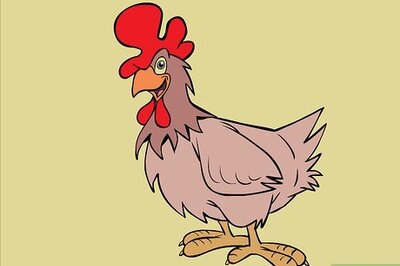


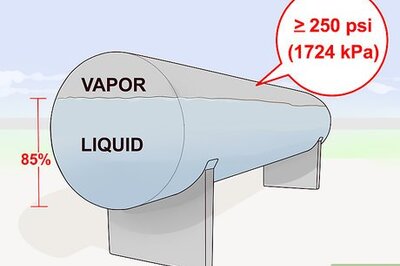

Comments
0 comment